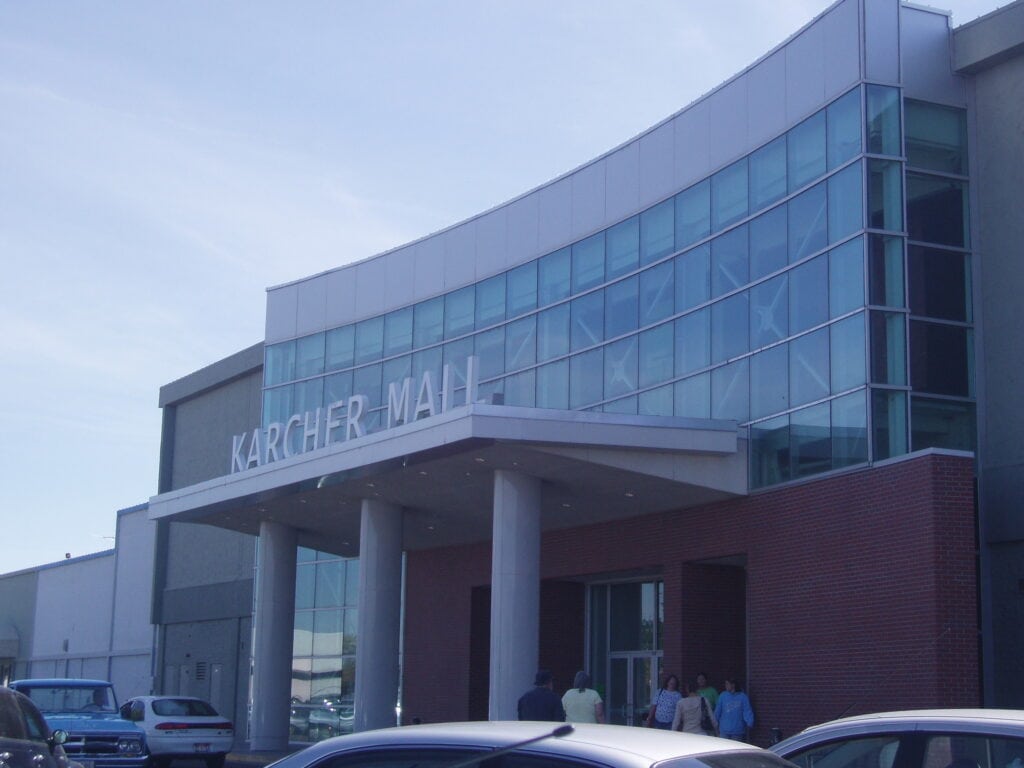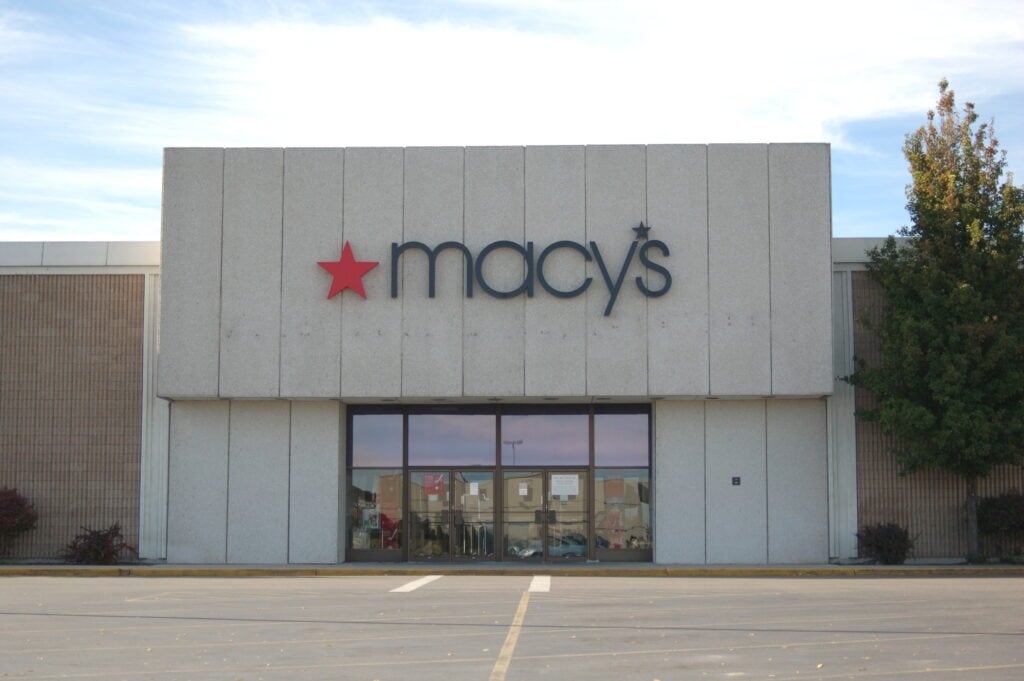The Birth of a Shopping Center: District 208 Mall's Early Years
Once upon a time, on August 26, 1965, Nampa witnessed the grand opening of an enclosed shopping center that would soon become a landmark.
Back then, Karcher Mall was a bustling hub featuring anchor stores like Tempo, Buttrey Food & Drug, and Sprouse-Reitz.
The mall was so popular that it expanded two years later, in 1967. This expansion welcomed new stores, including JCPenney and Skaggs Drug Centers, adding more variety and excitement to the shopping experience.
The mall was not merely a place to shop but a social gathering spot. Families would spend their weekends wandering through the stores, kids would hang out after school, and it was a go-to spot for holiday shopping.
The mall was also a venue for events, from fashion shows to car exhibitions, making it a vibrant part of the community.
During these early years, the mall was more than a shopping center; it symbolized growth and prosperity in Nampa. It was the place to be, and everyone knew it.
The mall's modern architecture was spacious corridors and elegant storefronts that attracted shoppers from all over Idaho.
The mall's success was also a sign of the times. The economy was booming, and people sought places to spend their hard-earned money.
Karcher Mall provided that space, offering a wide range of products and services that catered to the community's diverse needs.
So, if you were looking for things to do in Nampa, Idaho, District 208 was undoubtedly on your list during those years. It was not just a mall but a part of Nampa's identity, a place that held memories for many and promised a bright future.
The Golden Era: District 208 in the 1970s and 1980s
The 1970s and 1980s were the golden years for District 208 mall. In August 1973, the mall expanded again, adding Falk's I.D.
Store and The Bon Marché to its list of anchor stores. This expansion made the mall even more appealing, drawing in crowds from neighboring cities and other states.
In 1986, the mall changed hands and was sold to Standard Management Co. for about $14 million. This new ownership brought a fresh perspective and a $1 million renovation in 1987.
The renovation included aesthetic upgrades and the addition of new stores, making the mall a more attractive destination for shoppers.
During this period, the mall was a hub of activity. Seasonal sales, holiday events, and community gatherings were regular occurrences.
The mall was more than a collection of stores; it was a cultural center where people came to socialize, celebrate, and create memories.

The mall's success also reflected broader economic and social trends. The '80s were a time of financial prosperity, and people had disposable income to spend.
The mall capitalized on this, offering a range of high-end and affordable stores that catered to different demographics.
However, the golden era couldn't last forever. As the 1990s approached, the mall began to show signs of aging. Competition from newer, more modern malls started to impact foot traffic.
Yet, the mall remained a significant part of the community, where many had grown up and created lasting memories.
The Decline: District 208 in the 1990s and 2000s
The 1990s and 2000s were challenging times for District 208 Mall. The mall lost several anchor stores, including Anthony's and Woolworths, leading to decreased foot traffic.
In May 1998, the mall was purchased by Karcher Partners LLC for $10.9 million, signaling another change in ownership and a new direction for the mall.
The new owners had plans to revitalize the mall by attracting big-box chains like Costco and Home Depot. However, these plans never materialized, and the mall continued to struggle. The empty storefronts became more noticeable, and the mall lost its luster.
During this period, the mall also faced stiff competition from newer shopping centers and the rise of e-commerce.
The decline was evident, but the mall still had loyal customers who held onto the memories they had created there.

2004, the mall was sold again to LB Nampa Mall Holdings LLC. This new ownership brought some changes but was insufficient to reverse the decline.
The mall had lost its status as the go-to shopping destination in Nampa, and it was clear that something needed to be done.
The mall's decline was a local phenomenon and a broader trend affecting malls across America. The rise of online shopping and the changing retail landscape have made it difficult for traditional malls to survive.
Attempts at Revival: Renovations and Ownership Changes
It was sold to Milan Properties LLC in 2005 to breathe new life into the mall. The new owners had ambitious renovation plans to transform the mall into a modern shopping destination.
One significant change was the addition of Burlington Coat Factory in 2007, which brought some much-needed foot traffic.
Despite these efforts, the mall continued to struggle. The renovations were insufficient to attract new stores or bring back the crowds. The mall had lost its charm, and it was evident that more drastic measures were needed to revive it.
During this period, several other changes were made to attract visitors. The mall's interior was updated, and new lighting was installed to give it a more contemporary look. However, these changes were like putting a band-aid on a wound that required surgery.
The mall's decline was about losing stores, outdated design, and rental expenses. Despite the challenges, the mall's owners continued to search for ways to revive it. Various marketing campaigns were launched, and events were organized to attract visitors.
However, these efforts were not enough to turn the tide, and it was becoming increasingly clear that the mall's days were numbered.
District 208 Mall Today: A Shadow of Its Former Self
Fast forward to today, and District 208 is a shadow of its former self. In May 2019, the mall was sold to Rhino Investments, marking yet another change in ownership.
This sale led to the demolition of 81,000 square feet of the mall's floor area, signaling the end of the mall as a shopping destination.
The mall's transformation did not stop there. Many of the remaining stores closed their doors, and the mall started to look more like a ghost town. The once-bustling corridors were empty, and an eerie silence replaced the vibrant atmosphere.
Despite this, the mall's structure remained a relic of a bygone era. It stood as a reminder of what once was a place that had been a significant part of Nampa's community. While it was no longer the shopping hub it once was, it still held a nostalgic value.
Today, the mall is in the process of being transformed into residential buildings. The plan is to convert the mall into a mixed-use development featuring apartments, retail, and office spaces. While it's sad to see the mall go, it's also exciting to think about the future.
The mall's transformation is a sign of the times, a reflection of the changing needs and preferences of the community.
While it's hard to say goodbye, it's also essential to look forward to thinking about the new memories that will be created in this space. It's the end of an era and the beginning of something new with promise and potential.
District 208 Apartments: A New Chapter
Part of the mall is now being transformed into District 208 Apartments. This new development aims to offer modern, upscale apartments with various amenities, including a sparkling swimming pool and a fully equipped fitness center.
The apartments are designed to cater to current residents' needs, offering a mix of one-, two-, and three-bedroom residences.
The location is also a significant advantage. District 208 Apartments are near everything you need, from groceries and shops to restaurants.
The Treasure Valley marketplace is just a short walk away, and Lake Lowell is also nearby, offering a range of outdoor activities.
The mall's transformation into apartments is not just about providing housing; it's about creating a community.
The aim is to offer residents more than just a place to live; it's about providing a lifestyle and a sense of belonging. The apartments are designed to foster a warm, welcoming atmosphere, making it a great place to call home.
The apartments also offer a range of amenities designed to elevate the living experience. From a resort-style pool to a fully equipped fitness center, the aim is to provide residents with a comfortable and convenient lifestyle.
The apartments are more than just a place to live; they are a community waiting to be embraced.
The transformation of District 208 into apartments is a significant development for Nampa. It signifies the changing landscape, reflecting the community's evolving needs.
While the mall will always hold a special place in the hearts of those who grew up visiting it, it's exciting to think about the new memories that will be created in this space.
Conclusion
From the mall's early days as a bustling shopping center to its golden era and subsequent decline, it has been a significant part of Nampa's history. Its transformation into District 208 Apartments marks the beginning of a new chapter that holds promise and potential for the future.
The mall's journey reflects broader economic and social trends, from the rise of e-commerce to the changing retail landscape. While it's sad to see the mall go, it's also essential to look forward to thinking about the new opportunities that lie ahead.
The mall's transformation is not just about the end of an era; it's about the beginning of something new. It's about creating a community, offering a lifestyle, and meeting the evolving needs of the residents.
While the mall will always be remembered, its transformation provides a new beginning, a chance to create new memories and build a new community. It's a bittersweet ending and a new beginning, making it unique.
